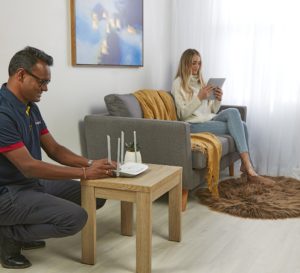Avoid hitting a brick wall with tech-related security
Have a think: that Wi-Fi router of yours. It’s a relatively safe little creature, right? But do you know if your firewall has been activated? Do you have a secure password, or is it a free-for-all? With more and more internet-enabled devices a normal part of everyday life, it’s worth knowing where your weak spots are, and where you may be at-risk to scams and hacks.
Unless you work in tech, it can be easy to feel completely stuck, not knowing who to turn to for help. Here’s a rundown on what you can do to make sure you and your family are safe and secure.
Internet-enabled devices
If the “Internet of Things” sounds like something out of a sci-fi movie to you, you’re not far off the mark. In simple terms, the Internet of Things is how the data of everything with a unique code identifier, is transferred across our digital networks. It’s how we can access the information we need from basically anywhere in the world, from your dog’s health records at the vet’s, to how many times you’ve called your internet company for help.
The thing with internet-enabled devices, is the more you use, the more likely you are to face hacks, scams or malware.
A small handful of security measures can go a long way in decreasing your exposure to risk:
- Create complex passwords with multi-factor authentication i.e. extra questions
- Consider investing in a Virtual Private Network (VPN) which connects you safely to internet from anywhere
- Make smart decisions on what you click on
- Protect your mobile in the same way you protect your computer
- Always make sure a site starts with ‘https’ instead of just ‘http’
- Keep all software up to date
- Keep abreast of recent scams

Your router
When it comes to home computer security, there are many weak points, and one of those is your router. This device is often overlooked, because the misconception is that it ‘just connects you to the internet’. Look at the bigger picture, it’s the one device in your home that connects you all to your home network.
Your home wireless router is designed to connect your wireless devices to the internet – fact. But it also has other useful security features. You can block certain websites from having access to your network, and you can use it to set timers on certain computers (a good one if you have kids!).
Make sure the firewall on your router is activated. Computers and laptops have their own in-built firewalls, but they only protect one computer. A router’s firewall will protect the network.
You can also protect your home network by making sure you set up the encryption and the password on your home router. Without these, anyone near your home will be able to connect to your network. Not only are they chipping into your data, they could be downloading something illegal.
Another option – limit your router to only allow certain devices. Proper maintenance of your router is essential to keeping your home network from any unwanted intruders.
You!
When it comes to cyber-security, sometimes humans can be their own worst enemy. While storing your personal financial information like credit card numbers is super handy for a spot of online shopping, you also run the risk of being scammed.
Malicious or criminal attacks, human error and system faults are the three main reasons for data breaches worldwide. You may not have control over any of those things, but here’s what you can control:
- Be 100% sure you know who you’re giving your personal and financial information to
- Safely dispose of personal information on old computers and mobiles
- Keep your browser secure and use data encryption software. Handy tip: a “lock” icon on the status bar of your internet browser means your information will be safe when it’s transmitted.
- Keep your passwords private
- Don’t overshare on social networking sites
Poor home tech security
Like your house, there are several points of entry for hackers to enter your network – not just the front door.
Your first line of defence is securing your home router. Fingbox is a great additional security tool that you can use to know who is on your network, block intruders and unknown devices, and monitor your Wi-Fi’s speed and performance.
To add a second layer of defence, consider installing anti-virus software and firewalls to protect your devices from online attacks.

Open Wi-Fi
Everyone loves a good open Wi-Fi – because it’s free! Leaving your personal home network open for all to use is like leaving the front door open to your house.
What you might not realise is anyone on your Wi-Fi can access your unsecured web traffic information – and in the wrong hands you could be looking a potential disaster.
Make sure your network is secure with a complex password and only give access to those people who you trust.
Don’t get lost on your way to safety
If you’ve hit a brick wall and have no idea where to start in securing your tech, the best security measure you can take is engaging the help of professionals.
Like your multi-functional home router, the experts at Noel Leeming’s Tech Solutions won’t just deliver your order. They can set up any new device and ensure its safety features have been enabled – and show you how to use or change them, do security review checks at your home, or give you advice on anti-virus software. If you’re feeling really lost, book in a one-on-one learning session with an expert to help you be a better, more confident internet user.
To get started with a health check of your technology’s security today, give Noel Leeming’s Tech Solutions a call.










Join the Discussion
Type out your comment here:
You must be logged in to post a comment.